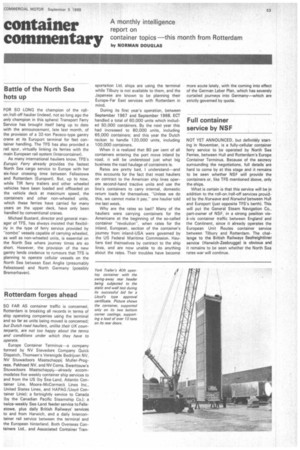container commentary
Page 55

If you've noticed an error in this article please click here to report it so we can fix it.
A monthly intelligence report on container topics this month from Rotterdam
by NORMAN DOUGLAS
Battle of the North Sea hots up
FOR SO LONG the champion of the rollon /roll-off haulier (indeed, not so long ago the only champion in this sphere) Transport Ferry Service has brought itself bang up to date with the announcement, late last month, of the provision of a 32-ton Paceco-type gantry crane at its Europort terminal for fast container handling. The TFS has also provided a rail spur, virtually linking its ferries with the main European rail system (Intercontainer).
As many international hauliers know, TFS's Europic Ferry already provides the fastest North Sea cargo service to Europe with her six-hour crossing time between Felixstowe and Rotterdam (Europort). But, up to now, while TIR ferry trailers and other wheeled vehicles have been loaded and offloaded on the vehicle deck at maximum speed, the containers and other non-wheeled units, which these ferries have carried for many years on the upper deck, have only been handled by conventional cranes.
Michael Bustard, director and general manager of TFS, has always insisted that flexibility in the type of ferry service provided by "combo" vessels capable of carrying wheeled, as well as non-wheeled units, is essential on the North Sea where journey times are so short. However, the provision of the new gantry lends credence to rumours that TFS is planning to operate cellular vessels on the North Sea between East Anglia (presumably Felixstowe) and North Germany (possibly Bremerhaven).
Rotterdam forges ahead
SO FAIR AS container traffic is concerned, Rotterdam is breaking all records in terms of ship operating companies using the terminal and so far as units being moved is concerned; but Dutch road hauliers, unlike their UK counterparts, are not too happy about the terms and conditions under which they have to operate.
Europe Container Terminus—a company formed by NV Stevedore Company Quick Dispatch, Thomsen's Verenigde Bedrijven NV, NV Stuwadoors Maatschappij Muller-Progress, Pakhoed NV. and NV Corns. Swarttouw's Stuwa doors Maatschappil,—already accommodates five weekly container ship services to and from the US (by Sea-Land, Atlantic Container Line, Moore-McCormack Lines Inc., United States Lines, and HAPAG /Lloyd Container Linie); a fortnightly service to Canada (by the Canadian Pacific Steamship Co.); a twice-weekly Sea-Land feeder service to Felixstowe, plus daily British Railways' services to and from Harwich, and a daily Intercontainer rail service between the terminal and the European hinterland. Both Overseas Containers Ltd., and Associated Container Tran spor-tation Ltd. ships are using the terminal while Tilbury is not available to them, and the
Japanese are known to be planning their Europe-Far East services with Rotterdam in mind.
During its first year's operation, between September 1967 and September 1968, ECT handled a total of 60,000 units which included 50,000 containers. By the next year this had increased to 80,000 units, including 65,000 containers; and this year the Dutch reckon to handle 120,000 units, including 100,000 containers.
When it is realized that 80 per cent of all containers entering the port move inland by road, it will be understood just what big business the road haulage of containers is.
Rates are pretty bad, I understand—and this accounts for the fact that most hauliers on contract to the American ship lines oper ate second-hand tractive units and use the line's containers to carry internal, domestic return loads for themselves. "Unless we do this, we cannot make it pay," one haulier told me last week.
Why are the rates so bad? Many of the hauliers were carrying containers for the Americans at the beginning of the so-called container "revolution", when rates for the inland, European, section of the container's journey from inland-USA were governed by the US Federal Maritime Commission. Hauliers tied themselves by contract to the ship lines, and are now unable to do anything about the rates. Their troubles have become more acute lately, with the coming into effect of the German Leber Plan, which has severely curtailed journeys into Germany—which are strictly governed by quota.
Full container service by NSF
NOT YET ANNOUNCED, but definitely starting in November, is a fully-cellular container ferry service to be operated by North Sea Ferries, between Hull and Rotterdam's Europe Container Terminus. Because of the secrecy surrounding the negotiations, full details are hard to come by at this stage and it remains to be seen whether NSF will provide the containers or, like TFS mentioned above, only the ships.
What is certain is that this service will be in addition to the roll-on/roll-off services provided by the Norwave and Norwind between Hull and Europort (just opposite TFS's berth). This will put the General Steam Navigation Co., part-owner of NSF, in a strong position visà-vis container traffic between England and the Continent, since it already operates the European Unit Routes container service between Tilbury and Rotterdam. The challenge to the British Railways Seafreightliner service (Harwich-Zeebrugge) is obvious and it remains to be seen whether the North Sea rates war will continue.






















































































































